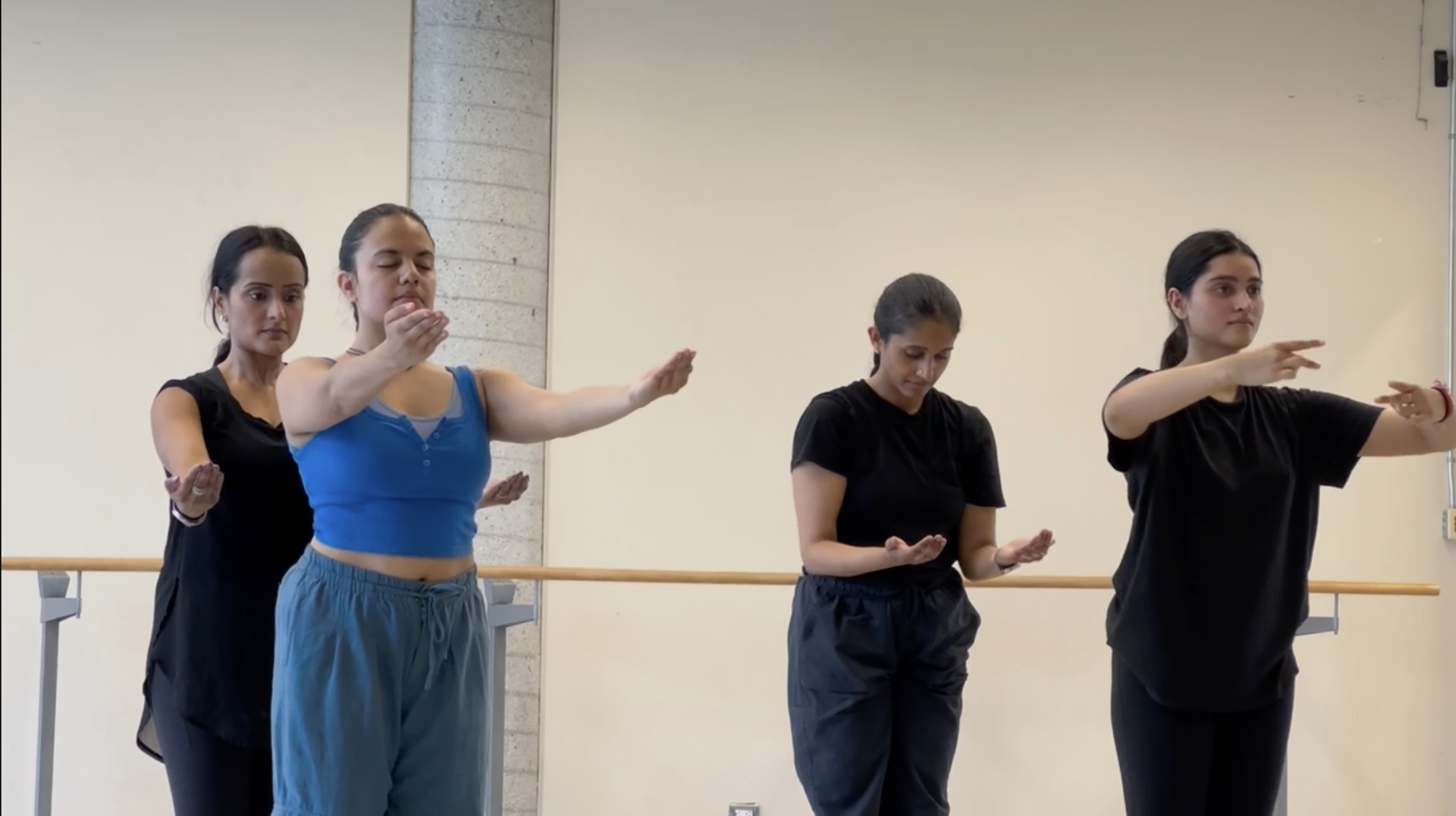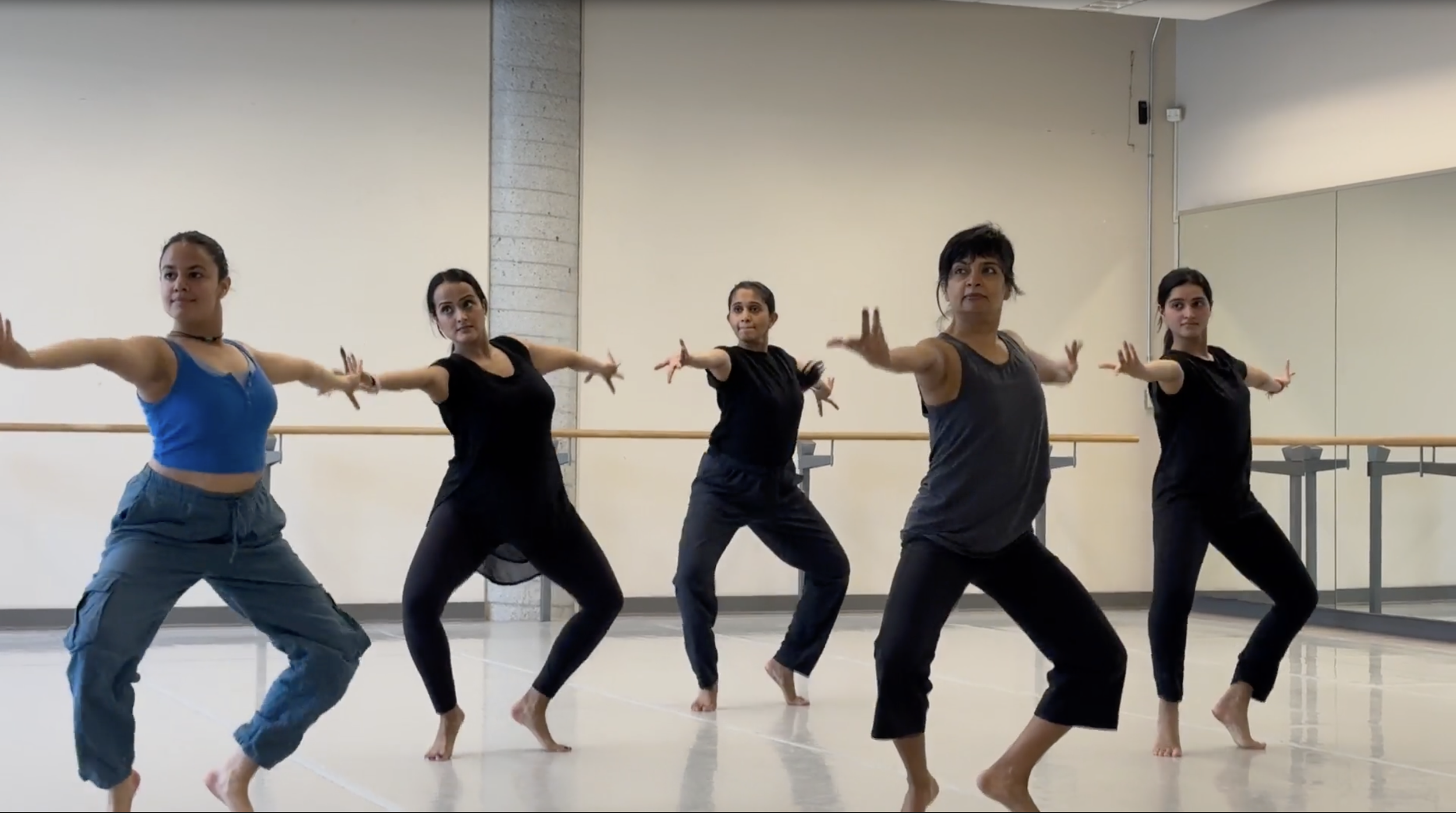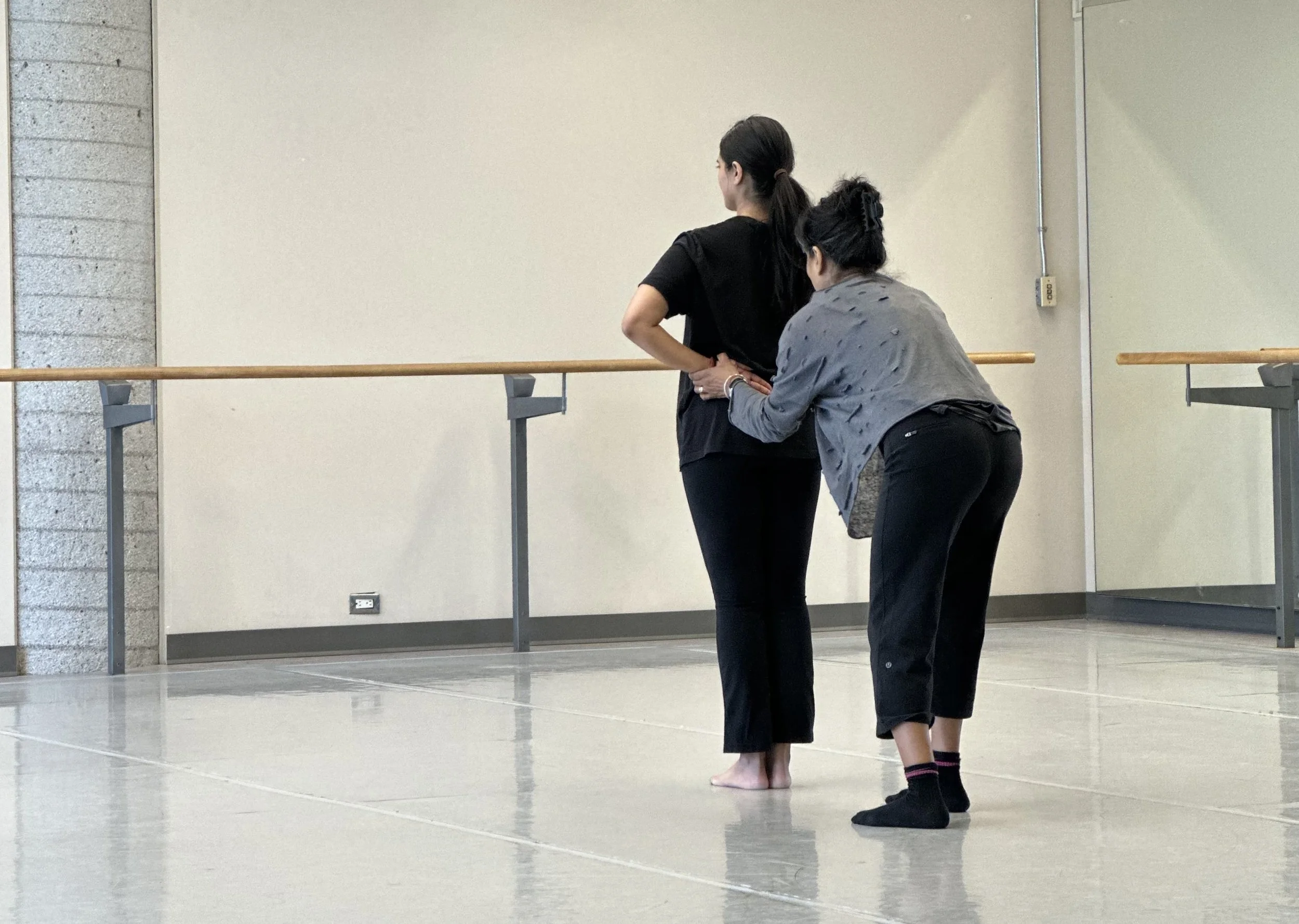Digging Deeper: A Conversation with Purawai Vyas on “Calm Abiding” by Judy Luo
Writer-in-Residence, Judy Luo, interviews Company Dancer, Purawai Vyas, on her experience learning and performing Calm Abiding last month:
In June, Nova Dance took part in Sharing Stage, a split bill with the National Ballet of Canada at the Richard Bradshaw Amphitheatre. Comprised of repertoire from both companies, Nova Dance opened the evening with Calm Abiding, a piece by artistic director Nova Bhattacharya and Montreal based choreographer José Navas. Originally premiered as a solo work performed by Nova herself in 2006, this piece of repertoire has had several iterations including a duet, a trio, and for the first time, a quartet for this show.
I had the chance to chat with the thoughtful Purawai Vyas who stepped into this work for her first time. Identifying “first, a Bharatanatyam dancer and then coming into the contemporary dance world,” she breaks down the piece into 6 sections: gestures/story time, jathi one (jathi, meaning rhythm section), first adage/pakka adavu, jathi two, second adage/100 year-old dancer, jathi three. Our conversation weaves between her experience learning and performing the work, the music, the title of the piece, and the labels of “traditional” and “contemporary.”
Selected moments from our dialogue below.
From left to right, Neena Jay, Rachana Joshi, Arrthami Suva-Kuruvinth, Purawai Vyas. Dancers rehearsing Calm Abiding. Photo by Rajvi Dedhia
J: There have been many iterations of this work. Tell me about your experience of the piece leading up to learning it. Had you seen it before? What were your impressions going in?
P: I had not seen the piece in its entirety before... [just] bits and sections. I remember one Deep End Week, they were working on Calm Abiding and I got sick. I wasn't there for the first three days and then I came in and it was truly deep end for me . . . the music would come on and I was told “respond. Watch and do what you want to do…” I saw people doing these gestures in silence, so I began copying them. Then I recognized some things that they were doing with the feet, so I started copying that. It was my first introduction to this piece - not knowing anything about it. It's something that looks simple, but it's actually very difficult because if you know the form and know the technique and you're training in it, everything that you want to do; that is autopilot in the form, this piece goes against that.
J: In what ways?
P: The little things . . . Like, the very ending. There's a whole section where we're going back in space using our footwork. For someone who actively trains in Bharatanatyam, we all know we always do everything on the right. We start with the right and our right foot is the strongest for doing that footwork. But for 24 times [in this section], we have to do it on our left foot . . . It’s a whole different kind of muscle building and calming yourself down because it’s just something you're not used to. If you told us to do it 24 times on our right foot, no problem, we could achieve that.
J: Putting myself into the shoes of dancer, [with] muscle memory and conventions, something as small as starting with the other foot or the other, it really switches things up.
P: 100% . . . the real beauty is in getting those details and specificity of the rhythmic sections and contrasting them with the slower sections and the things that really distort the form. Playing with this paradox is so satisfying and interesting from the inside as a dancer. It was really just the bare bones that me and Arrthami got to really experience for this process. But that in itself had so much information in it and was already so challenging and so much fun. With someone like Rachana, who's been with the piece for five years, and Neena, who's learned it over a year or longer - you can start to really see the difference between what those slower sections mean. For example, “crumbling down” and not leaving the form, but letting it be and letting it rest . . . it's almost just existing and they're trying to explore it within themselves. It is a hard switch to do, but once you've been with it for long enough, you can really start to see the difference between the sections and I think that's what the beauty of the piece really is.
From left to right: Rachana Joshi, Neena Jay, Arrthami Suva-Kuruvinth, Nova Bhattacharya, Purawai Vyas. Dancers rehearsing Calm Abiding with Nova. Photo by Rajvi Dedhia
J: Continuing off distortion and playing with paradox, something that's stood out to me across all versions of me witnessing the piece is the music. When I think of the use of synth or electronic sampling, it's quite common in our 21st century and in that way I don't think much of it. I imagined what it was like to hear this music to this work when it first premiered. In that sense, it feels so ahead of its time. With classical Indian dance, the relationship to music and instrument is really married. Talk to me a little bit about your experience dancing to this track in more familiar or traditional phrases.
P: Somehow, there were parts of it that were not so difficult [and] very relatable . . . I could still hear the rhythm clearly and in my head, and I was still saying the rhythm that worked for me . . . Even though the track is non-traditional, there are still [cues] in the music that help us respond for when we need to go to the next movement in time, but also to the quality of movement. In the adage, I always joked around with Nova in studio that, “oh, there it is, you're laughing at us again because we're tired and we can't get through the piece…” All the imagery around that part is also becoming older and withering away and “will dance exist in our life when we're 90 years old?” . . . So your body is exhausted, your mind is going through some sort of chaos. And then she's laughing at you through the track . . . that was a really fun moment in studio.
J: That also makes me think just because a section is slower, does not make it any easier, especially if it's coming after a fast section that requires a lot of exertion. It's just a different type of like tuning in and the slower sections actually don't read if we're not fully dialed in.
P: In Bharatanatyam, most things I've danced are fast. And I think that's with most Bharatanatyam dancers . . . we're always dancing fast, and then we're holding . . . we're still. To be moving slowly and engaging your body and to be present through slow movement, after doing something rhythmically fast like that requires so much work, energy and presence. Rachana's face would be red after we came up from the 2nd Adage... it was always a moment of catharsis, and you would always feel it. It's really hard not to connect with that part as a dancer, because it's so taxing on the mind and body. It requires everything from you. You can't cheat it. You just have to be there and engage the entire time.
“It brought me back to how I started learning and what I loved about Bharatanatyam when I was a student and not a performer. I was just there to dance...”
J: That really speaks to the craftsmanship of the work. I love it as a dancer when I don't have to fabricate something, when the repertoire actually takes me to that place and I have to commit to the task versus act like I'm tired or act in this specific way. There's both the challenge of having to step into that rigour, and an immense grace in that you can just be taken.
P: I think what’s lovely is that the tasks were so specific in this piece, partly because half of them were tied to the form and half of them were very specific in what she wanted and what she did as a soloist. The tiredness is a byproduct and it's fuelling the dance in its own way. It's not something I need to think about. In Bharatanatyam, you have to perform that you're not tired all the time . . . and in contemporary dance, sometimes you have to perform that you're tired. In this one, you just had to do it. I just have to get there on the beat in the simplest way possible. That was the beauty of this work. And that in itself, was the biggest challenge because the beats were all over the place.
J: I really see the influence of José in that. With what I have experienced in modern dance and post-modern dance, it’s “just do the thing,” and it's probably complex and requires so much of our focus that it brings expression in itself versus having to layer an emotional expression on top of it.
P: Exactly. . . It brought me back to how I started learning and what I loved about Bharatanatyam when I was a student and not a performer. I was just there to dance and just do the thing.
Purawai and Nova in rehearsal. Photo by Rajvi Dedhia
J: Do you know what the inspiration for the name of the piece is? What is one abiding to?
P: I don't know the original choreographers take on it. I don't know Nova's take at this moment. From what I understand through dancing it, is that there is so much happening internally as you go through the piece . . . you do what do you need to do inside of yourself to remain calm. Again, it's not the idea of performing calmness, but truly finding calmness within yourself so that you can perform the task . . .
Find the calmness in whatever I'm doing, being present and let it be. At the same time, it requires the work, like the actual grinding and working and practicing to know the material. It's not like I can trust myself and then fake it and I'll be okay because the material is so specific that you have to do both . . . It’s a balance.
J: Is there anything else as you're now recalling this experience that comes to mind?
P: We're still in a time where [this work] is quite different and it might be difficult for [classical trained audiences] to accept this kind of music to this work. They're not used to hearing sounds of like laughter and distortion of the voice. . .
. . . [They're] taking vocabulary from classical dance, you're taking the treatment from contemporary dance. I think Nova's been doing that a long time, but it's something that's still relevant and present . . . it's still cross-generational, cross-genre . . . I'm sure when you've seen Nova and Rachana do it, Nova does have moments of throwing the form away and changing up the vocabulary so that it's not held in this traditional way. I think part of the solo was supposed to be treated like that when she had first originally done it . . .
For this experience, we very specifically held on to the classiscim of the movement, the form, and the structure because we were at the Ballet and because of context. I'm sure it was different in Corner Brook. I'm sure it was different at CINARS. I'm sure there are different things that can be played with in different spaces . . .
A lot of the conventions around classical dance and music in Bharatanatyam don't match with the intention of this work, I think this work always be considered a contemporary dance work. Exciting things happening in Bharatanatyam spaces today that look very traditional can also be considered contemporary. It's just people who have not watched enough Bharatanatyam dance are not able to tell the difference or the change, because the vocabulary looks the same. I’m sure people who have not watched enough Ballet or contemporary dance, would not be able to tell the difference in terms of movement vocabulary. Today, the way people are treating music, the way people are approaching narrative, and how they're putting their own voices into their performance in contemporary Bharatanatyam spaces is not something that's been traditionally done for many years. What does one define as contemporary? Everyone has their own perspective.
"Calm Abiding” and other pieces of Nova Dance repertoire alike, evolve and deepen with each person and performance they are shared with. History carried by the vessels of dance works and dancing bodies continue to teach, shape and prompt reflection from those who encounter it today. To read other experiences of this piece, check out this reflection by Rachana Joshi.



